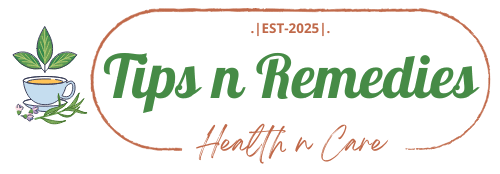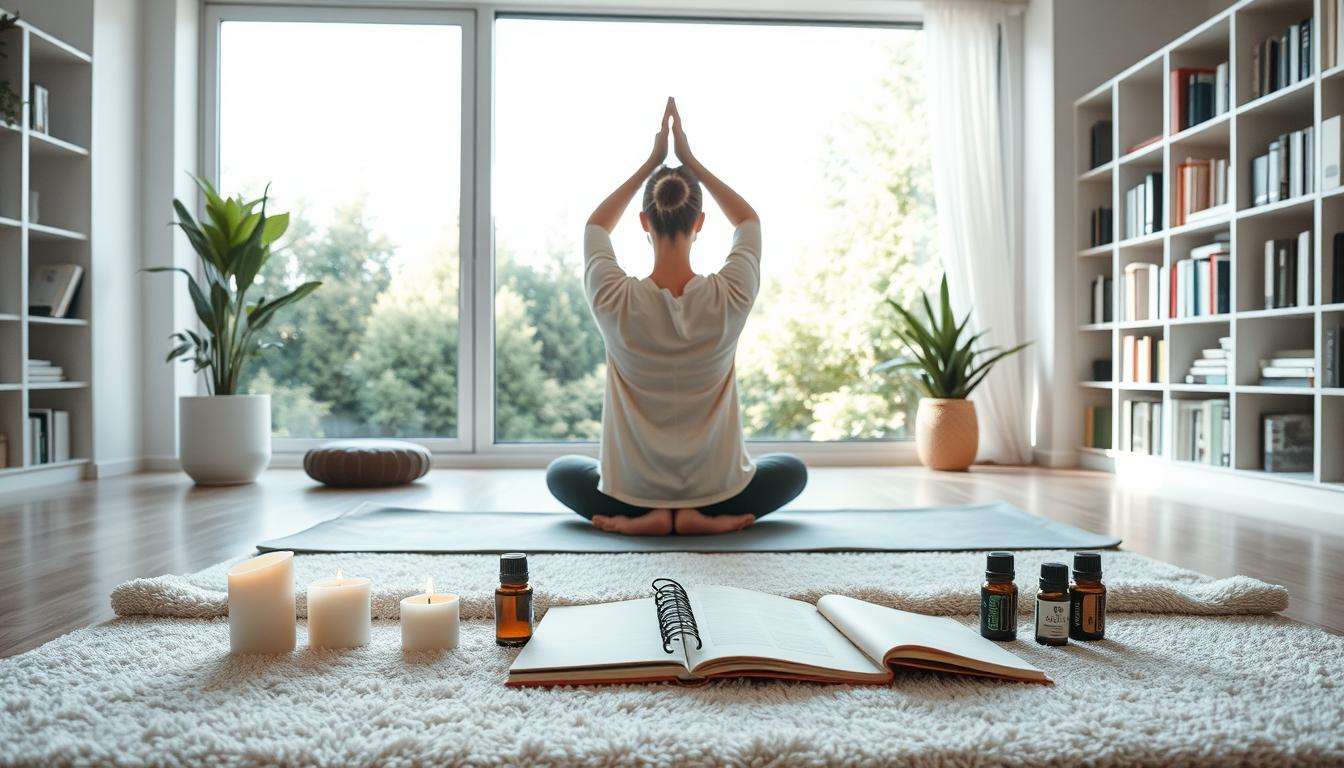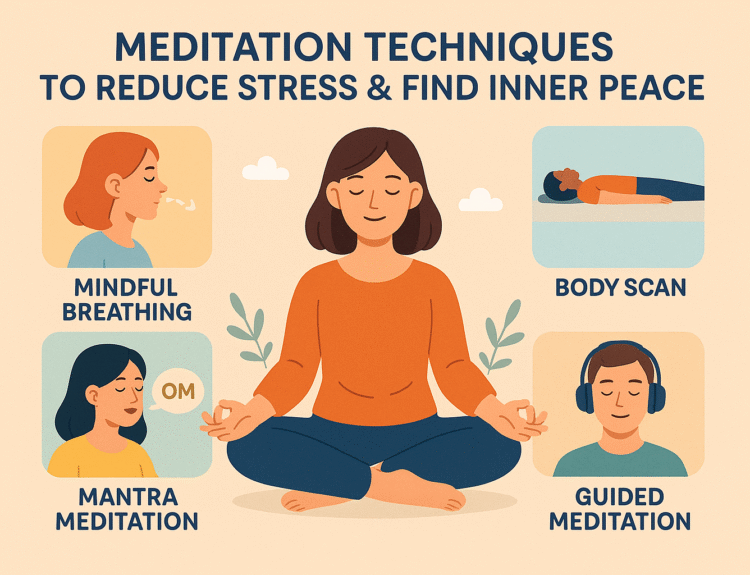Feeling overwhelmed and stressed? You’re not alone. Stress relief is essential for maintaining a healthy lifestyle, and self-care plays a significant role in managing anxiety.
Engaging in activities that support self-care may help reduce stress and anxiety
In today’s fast-paced world, it’s easy to get caught up in the hustle and bustle of daily life. However, neglecting our mental well-being can have severe consequences. This article will explore 16 simple ways to alleviate stress and promote relaxation, helping you regain control over your life.
Key Takeaways
- Discover effective techniques for stress relief
- Learn how self-care can improve your mental health
- Explore simple methods for anxiety reduction
- Find out how to incorporate relaxation techniques into your daily routine
- Improve your overall well-being with these easy-to-follow tips
Understanding Stress and Its Impact
Understanding stress and its far-reaching effects is crucial for maintaining overall well-being. Stress is a complex physiological and psychological response that can be triggered by various factors, including work-related pressures, financial concerns, and personal relationships.
How Stress Affects Your Body and Mind
Stress can have a profound impact on both physical and mental health. When we experience stress, our body’s “fight or flight” response is triggered, releasing hormones like cortisol and adrenaline. These hormones prepare our body to react to the stressor, but chronically elevated levels can lead to issues like anxiety, insomnia, and digestive problems. Chronic stress can weaken the immune system, making us more susceptible to illnesses.
Recognizing Your Personal Stress Triggers
Identifying personal stress triggers is a crucial step in managing stress effectively. Common triggers include work overload, financial worries, and relationship issues. Keeping a stress journal can help individuals become more aware of their triggers and patterns of stress. By understanding what causes stress, individuals can develop targeted strategies to mitigate its impact.
| Common Stress Triggers | Potential Impact |
| Work Overload | Anxiety, Burnout |
| Financial Worries | Insomnia, Digestive Issues |
| Relationship Issues | Emotional Distress, Social Withdrawal |
As Dr. Hans Selye, a renowned stress researcher, once said, “It’s not stress that kills us, it is our reaction to it.”
“Adopting a healthy lifestyle, practicing relaxation techniques, and seeking social support are effective ways to manage stress.”
Physical Activity as Stress Relief
Exercise is a natural stress reliever that not only improves physical health but also boosts mental resilience. Engaging in regular physical activity can help reduce stress and anxiety by releasing endorphins, also known as “feel-good” hormones.
1. Regular Exercise: The Natural Stress Reducer
Regular exercise is a powerful tool for managing stress. It helps improve mood, reduce anxiety, and enhance sleep quality. Some effective stress-reducing exercises include:
- Brisk walking
- Jogging
- Swimming
- Cycling
These activities can be adapted to suit different fitness levels, making exercise accessible to everyone as a means of stress relief.
2. Yoga and Stretching for Tension Release
Yoga and stretching exercises are particularly beneficial for releasing physical tension and promoting relaxation. They help improve flexibility, reduce muscle tension, and calm the mind. Some popular yoga practices for stress relief include:
- Hatha yoga
- Yin yoga
- Restorative yoga
These practices combine physical postures, breathing techniques, and meditation to provide a holistic approach to stress management.
Breathing Techniques for Immediate Calm
In moments of high tension, conscious breathing can be a powerful tool for relaxation. By focusing on the breath, individuals can calm the mind and body, reducing the immediate effects of stress.
Deep Breathing Exercises
Deep breathing exercises involve taking slow, deep breaths through the nose, holding the breath for a few seconds, and then exhaling slowly through the mouth. This technique can help slow down the heart rate and promote relaxation. To practice deep breathing:
- Find a comfortable seated or lying position.
- Close your eyes and inhale deeply through your nose.
- Hold your breath for a count of four.
- Exhale slowly through your mouth.
- Repeat for several minutes.
Progressive Muscle Relaxation
Progressive muscle relaxation is another effective technique that involves tensing and relaxing different muscle groups in the body. This can help release physical tension and promote a sense of calm. To practice progressive muscle relaxation:
- Start with your toes and tense them for a few seconds.
- Release the tension and feel the relaxation spread through your toes.
- Move up through the body, tensing and relaxing each muscle group in turn.
By incorporating these breathing techniques into daily life, individuals can better manage stress and anxiety, promoting overall well-being.
Mindfulness and Meditation Practices
In today’s fast-paced world, incorporating mindfulness and meditation into your daily routine can be a game-changer for stress relief. Mindfulness involves being fully present and engaged in the current moment, while meditation is a practice that helps train your mind to achieve a state of calm and awareness.
Mindfulness and meditation have been shown to have numerous benefits, including reducing stress and anxiety, improving sleep quality, and enhancing emotional well-being. As Jon Kabat-Zinn, a renowned mindfulness expert, once said, “You can’t stop the waves, but you can learn to surf.” This quote encapsulates the essence of mindfulness and meditation in navigating life’s challenges.
5. Guided Meditation for Beginners
For those new to meditation, guided meditation is an excellent starting point. It involves following a gentle, guiding voice that leads you through a meditation practice, often with a focus on relaxation, visualization, or breathing techniques. Guided meditations can be found through various apps, online resources, and local classes.
Guided meditation can help beginners establish a consistent practice, build confidence, and experience the benefits of meditation more quickly. As you progress, you can explore different types of guided meditations to find what works best for you.
6. Mindful Awareness in Daily Activities
Mindful awareness is not limited to formal meditation practice; it can be incorporated into daily activities to enhance your overall sense of calm and focus. This involves paying attention to your thoughts, feelings, and sensations as you engage in routine tasks such as eating, walking, or even doing the dishes.
By bringing mindfulness into your daily activities, you can transform mundane tasks into opportunities for relaxation and self-reflection. As you cultivate this awareness, you may find that you become more present and less reactive to stressors in your environment.
As
“The present moment is the only moment available to us, and it is the door to all moments.”
by
Thich Nhat Hanh
so eloquently puts it, mindfulness can open us to the richness of the present.
Engaging in Activities That Support Self-Care May Help Reduce Stress and Anxiety
Engaging in self-care activities is essential for managing stress and anxiety in our daily lives. By prioritizing self-care, individuals can better cope with the demands of modern life and improve their overall well-being.
Creating a Personal Self-Care Routine
Developing a self-care routine that suits your lifestyle and preferences is crucial for effective stress management. This can include activities such as reading, practicing meditation, or simply spending time in nature. The key is to identify what brings you relaxation and joy, and make it a regular part of your routine.
For instance, setting aside time each day for a relaxing activity can help signal to your mind and body that it’s time to unwind. As Audrey Lorde once said, “Self-care is not self-indulgence, it is self-preservation.”
“Caring for myself is not self-indulgence, it is self-preservation.” – Audre Lorde
Relaxing Baths and Aromatherapy
One of the most effective ways to unwind is by taking relaxing baths. Adding Epsom salts or essential oils like lavender can enhance the experience, promoting deep relaxation and reducing muscle tension. The aromatherapy benefits of these oils can have a profound impact on both mental and physical health.
For example, lavender oil is known for its calming properties, while chamomile oil can soothe and calm the mind. Incorporating these into your bath routine can be a simple yet effective way to manage stress. As part of your self-care routine, relaxing baths can become a cherished ritual, offering a moment of peace in a busy day.
By incorporating these practices into your daily life, you can take significant steps towards reducing stress and anxiety, ultimately leading to a more balanced and fulfilling life.
Nature as a Healing Force
Nature has long been recognized as a powerful tool for healing and stress relief. Spending time outdoors can have a profound impact on both physical and mental health, offering a respite from the demands of modern life.

nature therapy
Forest Bathing and Outdoor Walks
Forest bathing, or Shinrin-yoku, is a traditional Japanese practice that involves immersing oneself in the forest atmosphere. Studies have shown that this practice can lower cortisol levels, blood pressure, and heart rate, while also improving mood and cognitive function. Similarly, outdoor walks can provide an opportunity to disconnect from technology and reconnect with the natural world, promoting a sense of calm and well-being.
Gardening and Plant Care
Gardening is another activity that allows individuals to engage with nature, fostering a sense of accomplishment and relaxation. The physical act of gardening can be therapeutic, while the nurturing aspect of caring for plants can provide emotional benefits. Research has highlighted the gardening benefits, including reduced stress levels and improved mental health outcomes.
By incorporating nature into our daily lives, whether through forest bathing, outdoor walks, or gardening, we can harness the healing potential of the natural world to improve our overall well-being.
Creative Expression for Emotional Release
Creative expression offers a unique outlet for emotional release and stress relief. Engaging in creative activities allows individuals to channel their emotions into something tangible, providing a sense of accomplishment and calm.
One of the most effective ways to tap into creative expression is through art and music therapy. These therapies have been shown to reduce stress and anxiety by providing a healthy outlet for emotions. Art therapy involves creating visual art to express and process emotions, while music therapy uses music to promote relaxation and well-being.
11. Art and Music Therapy
Art therapy can involve various mediums, such as painting, drawing, or sculpting. The act of creating art can be meditative, allowing individuals to focus on the present moment and let go of worries. Music therapy, on the other hand, can involve listening to calming music or creating music oneself. Research has shown that music therapy can lower cortisol levels, heart rate, and blood pressure, all indicators of stress.
12. Journaling and Writing Exercises
Another powerful tool for emotional release is journaling and writing exercises. Writing down thoughts and feelings can help individuals process and release them, gaining clarity and perspective. Journaling can be done in various formats, from free-writing to structured prompts, and can be a therapeutic way to manage stress and anxiety.
By incorporating creative expression into daily life, individuals can develop a valuable tool for managing stress and promoting overall well-being.
Social Connections and Stress Management
Social connections play a crucial role in stress management and overall well-being. Nurturing these connections can provide emotional support, practical help, and a sense of belonging, all of which are vital for managing stress.
The Power of Meaningful Conversations
Engaging in meaningful conversations can significantly reduce stress levels. Sharing experiences and feelings with others can provide relief and help individuals gain new perspectives on their challenges.
To foster meaningful conversations, consider the following strategies:
- Practice active listening by focusing on the speaker and avoiding interruptions.
- Show empathy and understanding through verbal and non-verbal cues.
- Ask open-ended questions to encourage deeper sharing.
Setting Healthy Boundaries in Relationships
Setting healthy boundaries is essential for maintaining positive relationships and managing stress. Boundaries help define what you are comfortable with and what you are not, reducing the potential for conflict and emotional overload.
| Boundary Type | Description | Example |
| Emotional | Limiting emotional investment | Saying “I’m not discussing that topic” |
| Physical | Defining personal space | Communicating your need for alone time |
| Time | Managing time commitments | Learning to say “no” to non-essential tasks |
By cultivating meaningful conversations and setting healthy boundaries, individuals can strengthen their social connections, ultimately enhancing their ability to manage stress.
Nutrition and Hydration for Stress Resilience
Nutrition and hydration are fundamental components of a stress-resilient lifestyle. The food we consume and the fluids we drink play a significant role in how our bodies respond to stress.
Stress-Fighting Foods and Herbal Teas
Incorporating stress-fighting foods into your diet can help mitigate the effects of stress. Foods rich in omega-3 fatty acids, such as salmon, and those high in antioxidants, like berries, are particularly beneficial. Herbal teas, including chamomile and lavender, have calming effects and can be a soothing addition to your daily routine.
Key Stress-Fighting Foods:
- Fatty fish (salmon, sardines)
- Nuts and seeds (almonds, chia seeds)
- Fruits (berries, oranges)
- Leafy greens (spinach, kale)
Hydration’s Role in Mood Regulation
Hydration is crucial for maintaining emotional balance. Even mild dehydration can lead to irritability, anxiety, and fatigue. Drinking enough water throughout the day helps regulate mood and supports overall mental health.
| Hydration Level | Mood Impact |
| Adequately Hydrated | Stable mood, better focus |
| Mildly Dehydrated | Irritability, anxiety |
| Severely Dehydrated | Confusion, fatigue |

hydration for stress resilience
Sleep Hygiene and Stress Reduction
Sleep hygiene plays a significant role in stress reduction, impacting both mental and physical health. Practicing good sleep hygiene can help improve the quality of sleep, leading to better stress management.
Creating a Restful Sleep Environment
Creating a restful sleep environment is crucial for improving sleep quality. This involves making your bedroom a sleep sanctuary. Ensure your bedroom is dark, quiet, and cool. Consider using blackout curtains and earplugs if necessary. Invest in a comfortable mattress and pillows to support a restful night’s sleep.
Bedtime Routines That Promote Relaxation
Establishing a bedtime routine can signal to your body that it’s time to sleep. This can include activities such as reading a book, taking a warm bath, or practicing gentle stretches. Avoid screens and electronic devices at least an hour before bedtime, as the blue light they emit can interfere with your body’s production of melatonin, a hormone that regulates sleep.
By combining a restful sleep environment with a relaxing bedtime routine, you can significantly improve your sleep hygiene and reduce stress.
Time Management and Prioritization Skills
By mastering time management and prioritization, you can reduce feelings of overwhelm and anxiety. Effective time management enables you to accomplish tasks efficiently, allowing for a better balance between work and personal life.
Prioritizing tasks is essential to managing your time effectively. It involves identifying the most critical tasks that need to be completed and allocating your time accordingly.
Breaking Down Overwhelming Tasks
Large tasks can be daunting and may lead to procrastination. Breaking them down into smaller, manageable tasks makes them less overwhelming and more achievable. This approach also helps in creating a clear plan of action.
For instance, if you’re working on a significant project, divide it into smaller tasks such as research, outlining, drafting, and editing. This division makes the task less intimidating and allows you to focus on one step at a time.
Learning to Say No and Set Limits
One of the critical aspects of effective time management is learning to say no to non-essential tasks that can derail your focus. Setting healthy boundaries protects your time and energy, enabling you to concentrate on your priorities.
It’s essential to evaluate requests and commitments carefully. If taking on something new will interfere with your existing priorities, it’s okay to decline or negotiate deadlines. This practice helps maintain a manageable workload and reduces stress.
Conclusion: Building a Personalized Stress Management Toolkit
Now that you’ve explored the 16 simple ways to relieve stress, it’s time to create a personalized stress management toolkit that works best for you. By incorporating physical activity, breathing techniques, mindfulness, and self-care into your daily routine, you can effectively manage stress and improve your overall well-being.
Building a stress management toolkit is about finding the right combination of techniques that suit your lifestyle and preferences. Whether it’s practicing yoga, journaling, or spending time in nature, identify the activities that bring you calm and make them a regular part of your routine.
By developing a personalized stress relief plan, you can take control of your stress and enhance your resilience. Start by experimenting with different techniques, and don’t be afraid to mix and match until you find what works best for you. With a tailored stress management toolkit, you’ll be better equipped to handle life’s challenges and maintain a sense of calm and well-being.
FAQ
What are some simple ways to relieve stress?
There are 16 simple ways to relieve stress, including regular exercise, yoga, deep breathing exercises, progressive muscle relaxation, guided meditation, mindful awareness, self-care routines, relaxing baths, aromatherapy, forest bathing, outdoor walks, gardening, art and music therapy, journaling, and creating a restful sleep environment.
How does stress affect the body and mind?
Stress can manifest in different ways, affecting both the body and mind. It can cause physical symptoms like tension and fatigue, as well as emotional symptoms like anxiety and irritability.
What are some stress-fighting foods and herbal teas?
Certain foods and herbal teas, such as those high in omega-3 fatty acids, vitamin C, and complex carbohydrates, can help combat stress. Examples include salmon, dark chocolate, and herbal teas like chamomile and peppermint.
How can I create a restful sleep environment?
To create a restful sleep environment, consider factors like darkness, quiet, and a comfortable temperature. You can also try using blackout curtains, earplugs, or a white noise machine to promote relaxation.
What is mindfulness, and how can it help with stress relief?
Mindfulness involves being present in the moment, paying attention to your thoughts and feelings without judgment. Practicing mindfulness can help reduce stress and anxiety by promoting relaxation and improving emotional regulation.
How can I prioritize tasks and manage my time more effectively?
To prioritize tasks and manage your time more effectively, try breaking down large tasks into smaller, manageable steps. You can also learn to say no to non-essential tasks and set limits on your workload to reduce feelings of overwhelm.
What is the role of hydration in stress resilience?
Hydration plays a crucial role in mood regulation and stress resilience. Drinking enough water can help reduce symptoms of anxiety and depression, while dehydration can exacerbate stress and fatigue.
How can I incorporate physical activity into my daily routine?
To incorporate physical activity into your daily routine, try scheduling exercise into your daily planner or finding activities that you enjoy, such as walking, yoga, or dancing. You can also try incorporating small amounts of physical activity into your daily routine, such as taking the stairs instead of the elevator.
Share this content:








